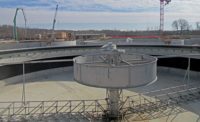After days of heavy rain fell on frozen ground throughout the Omaha area, a sudden thaw began on March 15, triggering a “bomb cyclone” event. Rivers and creeks rapidly flooded and the levees adjacent to the Papillion Creek Water Resource Recovery Facility were overtopped, forcing staff to shut down power and evacuate the wastewater treatment facility as floodwaters began to inundate it. Access roads were quickly submerged, and a majority of the 260-acre facility was covered in feet of water, rendering the plant’s critical infrastructure unusable.
The National Oceanic and Atmospheric Administration reported record precipitation across the Northern Plains, Great Lakes and portions of the Central Plains in 2019. It was also the second consecutive wettest year ever for the Midwest with 46.09 in. of precipitation—3 in. more than the previous record of 43.06 set in 2018. Across the entire Midwest, the flooding caused $6.2 billion in damage. Much of that runoff went directly to the Missouri River, which suffered breaches throughout Nebraska.
The Facility
The Papillion Creek plant serves about two-thirds of Omaha’s metropolitan area, cleaning wastewater and releasing clean water into the Missouri. The plant is situated near where the 15-mile creek meets the river. Plant manager David Sykora was the first on site when the floodwaters receded. There was no access or power, more than 2,800 ft of submerged underground utility and equipment tunnels, raw sewage and hazardous waste across the site, inoperable electrical and ventilation systems, and high water levels on the creek causing continued security and safety concerns. The command center that hosts the plant’s servers that automate much of the plant and the administration building next door were flooded too.
“Communication was absolutely key to the emergency recovery. Even before floodwaters receded, we worked with the city to determine time frames for restoration of plant components.”
– Ron Sova, Senior Vice President, HDR
All wiring, panels, disconnects, lighting and communication systems that were wet needed refurbishment or replacement. Pumps that were submerged had to be refurbished and would eventually need to be replaced. Primary treatment system components, including grinders and associated pumps also had to be replaced, along with components of the disinfection and digestion system.
Damages totaled $35 million at the plant, and Omaha’s Public Works Dept. had to keep the plant shut down for 33 days and were forced to pump raw sewage into the Missouri River the entire time. The longest period of time the plant had ever been out of commission previously was three days. Plant manager David Sykora says he thought it would take four or five months to repair the levee damage and get the Papillion Creek plant running again.
“Communication was absolutely key to the emergency recovery,” says Ron Sova, senior vice president at HDR, which was brought in to manage the design aspects of the recovery. “Even before floodwaters receded, we worked with the city to determine time frames for restoration of plant components. Together, a unique process was quickly developed to implement specific task orders under the city’s emergency procurement methods.”
Rapid Response
HDR, hired as the program manager for Omaha’s public works department, created a team that combined emergency management professionals with technical expertise in all areas of engineering required for the project, including electrical, structural, civil, wastewater process, mechanical and architectural. Use of Omaha’s emergency procurement processes resulted in FEMA reimbursement for the $45-million repair cost. Within two weeks, 80 task orders were developed for site cleanup and emergency repairs to restore full facility operations. A total of 126 emergency task orders were eventually written for the project.
HDR and the city of Omaha sent in a “SWAT team” of public health professionals and cleaning personnel to clean and disinfect the buildings as soon the waters lowered days after the flood, when it was still too early for contractors to safely enter the site. At this point, the team also discovered that most of the records and operations manuals at the 1970s-designed plant were still on paper and had been destroyed or badly damaged by the flood.
The design drawings were also stored off site and digitally with the engineer of record, but the process data, maintenance records and operations and maintenance manuals only existed as paper documents at the site. Records recovery included meticulous and time-consuming handling, drying and processing, sometimes on a page-by-page basis. This also included plant record drawings, personnel files and regulatory documents.
Construction
When contractors Eriksen Construction and Rohloff Construction arrived in late March, a plan had been developed to partition the work into manageable task orders.
“By the time [we were hired], the water had receded from around the plant, most of the tunnels were still submerged, but the actual waste in the water and so forth, most of it had dissipated or went back out through the breach of the levee,” says Tim Shaw, president of Eriksen Construction. “I think we had 102 or 105 task orders—separate bid projects. That way they were able to give us tasks and we would go out and price them. Then HDR would check the pricing and then they would issue us a purchase order and proceed with the tasks.”
“Even with the additional levee height that is being added in this area, the severity of the flood that impacted the plant in 2019 would have still resulted in overtopping of the flood control system.”
– Jim Theiler, Assistant Director for Environmental Services, Omaha Public Works Dept.
One of those tasks was refurbishing the six influent pumps that were completely submerged and inoperable. New pumps were specified for the project, but they would take 10-12 months to be built and delivered, and Omaha needed a solution in weeks, not months. Within two weeks, Fairbanks Morse Pump of Kansas City, Kan., received, refurbished and returned the first three influent pumps to the site and Eriksen reinstalled them. The other three returned a week later.
Preparations are underway for installation of the new permanent pumps in the coming weeks along with influent slide gates.
Shaw says Eriksen and Rohloff were able to start processing task orders about two weeks faster than what the original best timeline was. Specialty contractors came from as far away as Tampa to work on the two-shift project.
“We were able to start processing, and they never dreamed we were going to start that quick. But again, it was everybody—the suppliers, everybody bent over backwards to do whatever they could to help,” Shaw says.
When Eriksen arrived on site, everything that was within the digester complexes in the lower part of the plant was destroyed. Having so many trade contractors from across the country available helped to expedite and repair or replace the mechanical, electrical and piping systems destroyed by the flood.
Primary treatment and solids dewatering were restored in mid-April, with complete pre-flood treatment restored by May 15, approximately two months after the flood.
In addition to the rapid repairs, changes were made to the levees along the Missouri and Papillion Creek to deal with future floods by raising them 2 ft, a $30-million project. However, just how high levees can be built safely and how high the water could rise could still leave the plant vulnerable to a repeat of 2019’s frozen ground bomb cyclone.
“The levee that protects the plant is being raised with a project that had been planned for a number of years prior to the flooding,” says Jim Theiler, assistant director for environmental services for the Omaha Public Works Dept. “Even with the additional levee height that is being added in this area, the severity of the flood that impacted the plant in 2019 would have still resulted in overtopping of the flood control system and a catastrophic failure of the plant.”










Post a comment to this article
Report Abusive Comment